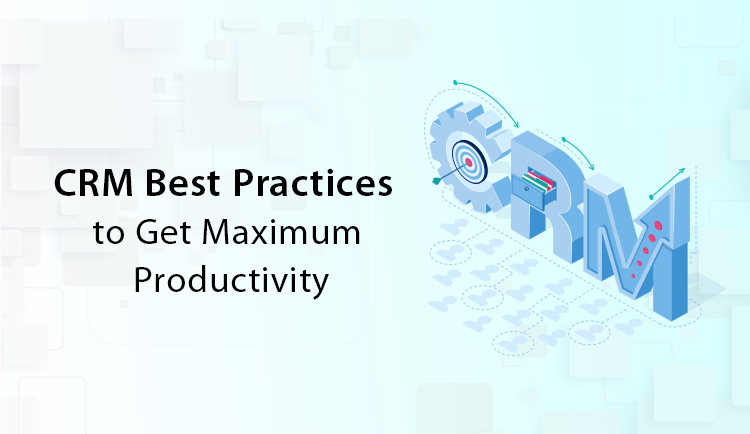
10 CRM Best Practices to Get Maximum Productivity
CRM, also known as customer relationship management, is no new concept now. It has gained immense popularity in the past few decades, and trust that for all the good reasons! Deploying CRM best practices can help you tremendously.
Good customer relationship management can be a game-changer for your business. Gone are the days when only the quality of your product mattered. Today, it is not just about the quality or best pricing of your product – it is more than that!
Today’s customers are DIFFERENT, POWERFUL, and VIGILANT! They have the power of information. They observe you at all levels, especially how you make them feel when they purchase from you.
Research indicates that 83% of online shoppers seek assistance from customer service representatives even before they complete a purchase. That’s the reason more and more businesses are now investing in robust customer relationship management.
However, implementing a CRM system in your business is not that easy as it appears. To ensure that you’re on the right track, you must adhere to CRM best practices.
Wondering, what are those best CRM practices?
Well, the answer to your question is in this post only.
In this article, we are sharing 8 CRM best practices you can cohere to obtain maximum benefits.
Ready to explore?
Here we go…
Before we dive deep into the CRM best practices, let’s take a look at what CRM is.
What is CRM?
CRM is a software system that assists business owners in nurturing their customer relationships. It provides multi-functional benefits to any size organization.
It aids in organization, improving productivity and efficiency, time management, and impressing clients at every stage of the process. CRM platforms are potent systems that centralize all of your sales leads and customers’ data.
A CRM keeps track of your prospects’ personal information, purchase history, progress, preferences, and other information and makes it available and accessible from a single, central location.
That’s not all; CRM technology can take you much further!
Why should businesses have a good CRM system?
Customers did not have as much information ten or more years ago as they do today. Today’s customers are vastly different from those of yesteryears.
Customers today are preoccupied with the day-to-day rigors of life. They have no time to deal with ineffective systems and practices when attempting to shop from your company. They want you to be there at every stage of their shopping experience. Understand that they are money-rich but time-poor! Your customers expect to be served promptly.
Customer relationship management is the most effective and efficient method of maintaining and developing customer relationships. It is more than just a business concept; it helps create strong personal bonds with your customers.
The development of this type of bonding propels the company to new heights of success. Once you succeed in establishing a strong bond with your customers, it becomes easier to identify their needs and serve them the best way in your capacity.
Therefore, implementing CRM best practices is indispensable. The more sophisticated the strategies used in implementing CRM systems, the stronger and more fruitful the business.
Let’s now take a look at the best CRM practices.
10 CRM Best Practices
1. Analyze your needs and goals.
The first and most important CRM implementation best practices are to analyze your needs and goals.
Acknowledge that not all CRMs are created equal; thus, selecting a CRM that meets your needs is critical.
If you select a CRM without thoroughly examining its functionalities (as well as its flaws), you may likely commit to a system that is inadequate for your business.
Ask yourself the following questions:
- Do you want a cloud-based CRM or one that runs on-premises?
- Do you want a CRM with a lot of customization options or one with basic features?
CRMs frequently include a plethora of features, some of which may or may not be applicable to your business. So, instead of going for the one with the most features, go for the one with all of the features you need for your business.
As a result, we recommend that you take your time and analyze your needs and objectives before deciding on one for your company.
You can choose anything, but the one with the necessary features is the best option.
2. Make the best use of CRM automation features.
Your employees must be working on a slew of redundant and repetitive tasks. As a matter of fact, these tasks take a significant amount of time and have an impact on overall efficiency.
It is recommended that you use CRM automation features to automate all time-consuming tasks. As one of the CRM best practices, doing so will expedite time-consuming tasks and increase efficiency.
Best CRMs come loaded with powerful automation features that can help you automate routine and mundane tasks. You can do everything from scheduling tasks to integrating and monitoring workflows all from one place.
All you have to do is to identify repetitive tasks and automate them, integrate communication channels into a single platform, that’s all!
3. Leverage the data to your advantage.
Other CRM best practices include making the best use of data. CRMs are designed specifically to collect and organize massive amounts of data. The best CRMs are those that include built-in analytics features that use advanced programming to mine all data collected.
Good data enables organizations to set frameworks, milestones, and goals in order to keep moving forward. However, more often than not, organizations fail to convert that data into anything valuable. Understand that if you don’t properly use the data that your CRM collects, all that valuable information is of no use.
Businesses that know the value of good data utilize it to their advantage. They use it to establish baselines, find benchmarks, set performance goals, generate valuable conclusions, make informed future business decisions, and expand their business.
4. Less is more
Contrary to popular belief, less is considered more when it comes to CRM best practices. When planning CRM implementation best practices, keep a straightforward approach in mind.
You may come across a plethora of CRM options with numerous (unnecessary) features. Don’t be overwhelmed with those features. Just be careful, and think about the CRM Best Practices no.1. Yes, the one that we discussed in the first place.
Remember that the best CRM is the one that meets your needs and goals the best. Don’t go with a CRM that’s crammed with features you’ll never use; instead, go with something simple but effective. This will help ensure that your team gets the most out of the CRM without becoming saddled by unnecessary features.
5. Link up your CRM to other tools.
One of the most important CRM best practices for increasing productivity and improving business processes is to integrate a CRM with your other tools.
Manually copying data from one system to another consumes time and increases the possibility of error. Furthermore, it has an impact on overall productivity.
Integrating your CRM with other tools, on the other hand, will help you avoid this. Aside from that, a robust CRM will assist you to complete the task in a timely manner and stay focused.
6. Systematize your resources.
Acknowledge that if an organization’s business processes are not systematized, the majority of employees’ time is wasted in document organization.
We don’t want you to be doing this!
Systemization is one of the most critical CRM best practices that allow your employees to access data from a centralized location.
As a result, centralize your critical documents such as business proposals, quotes, contracts, and so on. This will save time and allow everyone to retrieve information in seconds as needed.
7. Be proactive in your efforts.
If there is one constant in business, it is the need to provide the best possible service to customers at all times. You must be proactive in your efforts to stay ahead of the competition.
Using intelligent CRM analytics is another crucial CRM best practice for the best results. It will assist you in identifying new opportunities and responding to customer needs and concerns in a timely manner.
As a result, choose a CRM that can provide you with detailed and insightful analytics that you can use strategically to identify new market opportunities and gain a competitive advantage.
8. Embrace the change.
The only constant in the world is “change.” It is best to accept this fact as soon as possible. Business changes, in particular, are more rapid and potentially drastic. As a result, you need to be resilient and dynamic in your approach.
Take a flexible approach and be open to evolutionary changes, both with customers and with users, as one of the CRM best practices.
This necessitates the implementation of scalable and customizable software solutions, such as CRM.
9. Use AI-powered CRM systems
According to research, 87% of sales teams are dissatisfied with their CRM. This is due to manual processes or the difficulty in using CRM tools.
Thus, incorporating AI-powered CRM can help you improve your processes and reduce human intervention, ultimately saving you time and resources. As a result, employees can dedicate more time to focus on core activities, increasing productivity.
Use AI-powered systems to improve your processes as CRM best practices.
10. Make the most of your CRM’s customer experience features.
A critical CRM best practice includes leveraging customer experience features. Yes, if you want your customers to return to you always, then make the most of your CRM’s customer experience features. Today’s customers expect consistent services from brands. Allow your customers to have seamless digital experiences. Doing so will allow you to maximize your productivity and have a competitive advantage over others.




